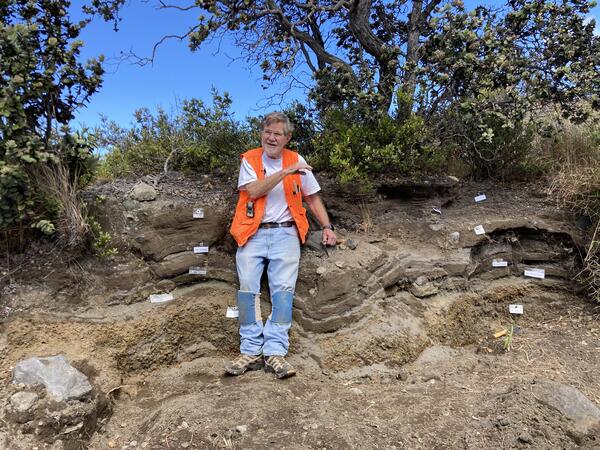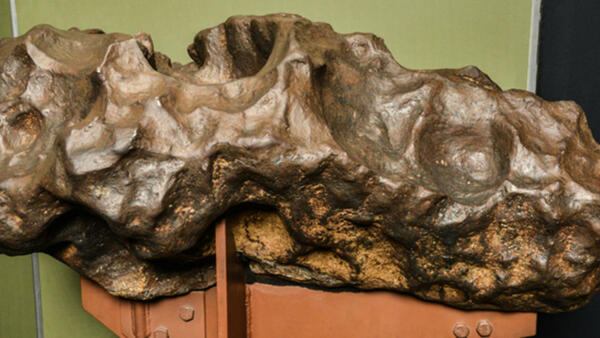A close up of the perched levee impounding the active lava lake in Halema‘uma‘u crater, at the summit of Kīlauea. Photo taken on January 10, 2022, from the south rim of Kīlauea caldera. USGS photo by M. Patrick.
Images
Volcano Hazard Program images.
A close up of the perched levee impounding the active lava lake in Halema‘uma‘u crater, at the summit of Kīlauea. Photo taken on January 10, 2022, from the south rim of Kīlauea caldera. USGS photo by M. Patrick.
A close up of the surface texture on the active lava lake in Halema‘uma‘u crater, at the summit of Kīlauea. The classic zig-zag pattern in apparent in the incandescent spreading zones between crustal plates that form on the surface of the lava lake. USGS photo by M. Patrick.
A close up of the surface texture on the active lava lake in Halema‘uma‘u crater, at the summit of Kīlauea. The classic zig-zag pattern in apparent in the incandescent spreading zones between crustal plates that form on the surface of the lava lake. USGS photo by M. Patrick.

This reference map depicts the ongoing Kīlauea summit eruption on January 7, 2022. One eruptive vent is intermittently active within Halemaʻumaʻu, along the western edge of the lava lake. When this vent is effusing lava, it pours into the active portion of the lake, colored red on this map.
This reference map depicts the ongoing Kīlauea summit eruption on January 7, 2022. One eruptive vent is intermittently active within Halemaʻumaʻu, along the western edge of the lava lake. When this vent is effusing lava, it pours into the active portion of the lake, colored red on this map.
Kyle R. Anderson is a Volcano Geophysicist who works at the USGS California Volcano Observatory.
Kyle R. Anderson is a Volcano Geophysicist who works at the USGS California Volcano Observatory.
Alexa Van Eaton is a physical volcanologist at the U.S. Geological Survey Cascades Volcano Observatory.
Alexa Van Eaton is a physical volcanologist at the U.S. Geological Survey Cascades Volcano Observatory.
John Pallister is a Geologist Emeritus with the USGS Volcano Hazards Program. He served as the VHP Director as well as the Director for the Volcano Disaster Assistance Program. He is based out of the Cascades Volcano Observatory in Vancouver, WA.
John Pallister is a Geologist Emeritus with the USGS Volcano Hazards Program. He served as the VHP Director as well as the Director for the Volcano Disaster Assistance Program. He is based out of the Cascades Volcano Observatory in Vancouver, WA.

Plots showing the correlation between Kīlauea summit sulfur dioxide emissions (SO2) in tonnes per day (top panel), ground tilt in microradians (middle panel), and seismic tremor (RSAM) (lower panel) for the period of November 1, 2021, to January 22, 2022. Eruptive pauses and highly diminished activity are highlighted in blue. USGS plots.
Plots showing the correlation between Kīlauea summit sulfur dioxide emissions (SO2) in tonnes per day (top panel), ground tilt in microradians (middle panel), and seismic tremor (RSAM) (lower panel) for the period of November 1, 2021, to January 22, 2022. Eruptive pauses and highly diminished activity are highlighted in blue. USGS plots.
Map of seismicity (red circles) in the Yellowstone region during 2021. Gray lines are roads, black dashed line shows the caldera boundary, Yellowstone National Park is outlined by black dot-dashed line, and gray dashed lines denote state boundaries.
Map of seismicity (red circles) in the Yellowstone region during 2021. Gray lines are roads, black dashed line shows the caldera boundary, Yellowstone National Park is outlined by black dot-dashed line, and gray dashed lines denote state boundaries.

Types of explosive clasts found in the debris fan deposits at the summit of Mauna Loa: (A) unaltered ponded lava flow, (B) unaltered pāhoehoe, (C) altered ponded lava flow, often has a red to pink hue, (D) thermally altered pāhoehoe, often has a red-to-pink hue, (E) gabbroic xenolith, the most crystalline rocks we found, (F) bread-crust outer surfaces and vesicular
Types of explosive clasts found in the debris fan deposits at the summit of Mauna Loa: (A) unaltered ponded lava flow, (B) unaltered pāhoehoe, (C) altered ponded lava flow, often has a red to pink hue, (D) thermally altered pāhoehoe, often has a red-to-pink hue, (E) gabbroic xenolith, the most crystalline rocks we found, (F) bread-crust outer surfaces and vesicular

Map of explosive deposits at the edge of Moku‘āweoweo, the summit caldera of Mauna Loa. Map showing the size distribution of ejecta, sorted by maximum length in centimeters (one inch is about 2.5 cm). The colors indicate the different size fractions in centimeters. The largest blocks were found closest to the rim.
Map of explosive deposits at the edge of Moku‘āweoweo, the summit caldera of Mauna Loa. Map showing the size distribution of ejecta, sorted by maximum length in centimeters (one inch is about 2.5 cm). The colors indicate the different size fractions in centimeters. The largest blocks were found closest to the rim.

Don Swanson describes the stratigraphy of Keanakāko‘i deposits near Uēkahuna Bluff at Kīlauea summit within Hawai‘i Volcanoes National Park.
Don Swanson describes the stratigraphy of Keanakāko‘i deposits near Uēkahuna Bluff at Kīlauea summit within Hawai‘i Volcanoes National Park.
(L) Green olivine crystals in lava from Mauna Loa’s 1868 eruption. (R) Microscope image of a single olivine crystal extracted from tephra at Kīlauea. This crystal is about 1 mm (less than 1/16 of an inch) tall.
(L) Green olivine crystals in lava from Mauna Loa’s 1868 eruption. (R) Microscope image of a single olivine crystal extracted from tephra at Kīlauea. This crystal is about 1 mm (less than 1/16 of an inch) tall.

Left photo shows a loose piece of siliceous sinter that was precipitated around a photosynthetic microbial mat in the Lower Geyser Basin. The microbial mat died when the outflow channel changed positions.
Left photo shows a loose piece of siliceous sinter that was precipitated around a photosynthetic microbial mat in the Lower Geyser Basin. The microbial mat died when the outflow channel changed positions.

Castle Geyser features and Scanning Electron Microscope image of algal filament in a silica sheath
linkOn the left is Castle Geyser during an eruption with a pool from nearby Tortoise Shell Spring showing photosynthetic pigments at the bottom. The middle image is of a small pool in the Geyser Hill Group in the Upper Geyser Basin with an outflow channel full of yellow, green, orange, red, and brown pigmented phototrophic microbial mats.
Castle Geyser features and Scanning Electron Microscope image of algal filament in a silica sheath
linkOn the left is Castle Geyser during an eruption with a pool from nearby Tortoise Shell Spring showing photosynthetic pigments at the bottom. The middle image is of a small pool in the Geyser Hill Group in the Upper Geyser Basin with an outflow channel full of yellow, green, orange, red, and brown pigmented phototrophic microbial mats.

A 200-kilogram (440-pound) fragment of the Canyon Diablo meteorite that was found at Meteor Crater in Arizona
linkA 200-kilogram (440-pound) fragment of the Canyon Diablo meteorite that was found at Meteor Crater in Arizona.
A 200-kilogram (440-pound) fragment of the Canyon Diablo meteorite that was found at Meteor Crater in Arizona
linkA 200-kilogram (440-pound) fragment of the Canyon Diablo meteorite that was found at Meteor Crater in Arizona.

Boiling River near Mammoth Hot Springs, Yellowstone National Park. Photo by R. Robinson.
Boiling River near Mammoth Hot Springs, Yellowstone National Park. Photo by R. Robinson.
Michael Randall is a software engineer who develops applications to view volcanic monitoring data for the USGS Volcano Science Center.
Michael Randall is a software engineer who develops applications to view volcanic monitoring data for the USGS Volcano Science Center.

Eruptive activity resumed today in Halema‘uma‘u crater, at the summit of Kīlauea volcano, after a brief pause of several days. This photograph shows spattering and lava effusion from the west vent, which has built a steep spatter cone. USGS image by M. Patrick.
Eruptive activity resumed today in Halema‘uma‘u crater, at the summit of Kīlauea volcano, after a brief pause of several days. This photograph shows spattering and lava effusion from the west vent, which has built a steep spatter cone. USGS image by M. Patrick.
During recent multi-day pauses in the ongoing Kīlauea summit eruption, a small portion of the Halemaʻumaʻu lava lake has consistently remained active: a small, ovular lava pond just north of the briefly dormant western fissure.
During recent multi-day pauses in the ongoing Kīlauea summit eruption, a small portion of the Halemaʻumaʻu lava lake has consistently remained active: a small, ovular lava pond just north of the briefly dormant western fissure.
Two weeks of earthquake activity preceding the September 29, 2021, eruption at Kīlauea summit. The regions of interest indicated on the map include: KS (Kīlauea summit); ML (Mauna Loa summit); P (Pāhala).
Two weeks of earthquake activity preceding the September 29, 2021, eruption at Kīlauea summit. The regions of interest indicated on the map include: KS (Kīlauea summit); ML (Mauna Loa summit); P (Pāhala).
Island of Hawai‘i Volcano Awareness Month 2022 calendar of programs, with descriptions.
Island of Hawai‘i Volcano Awareness Month 2022 calendar of programs, with descriptions.












